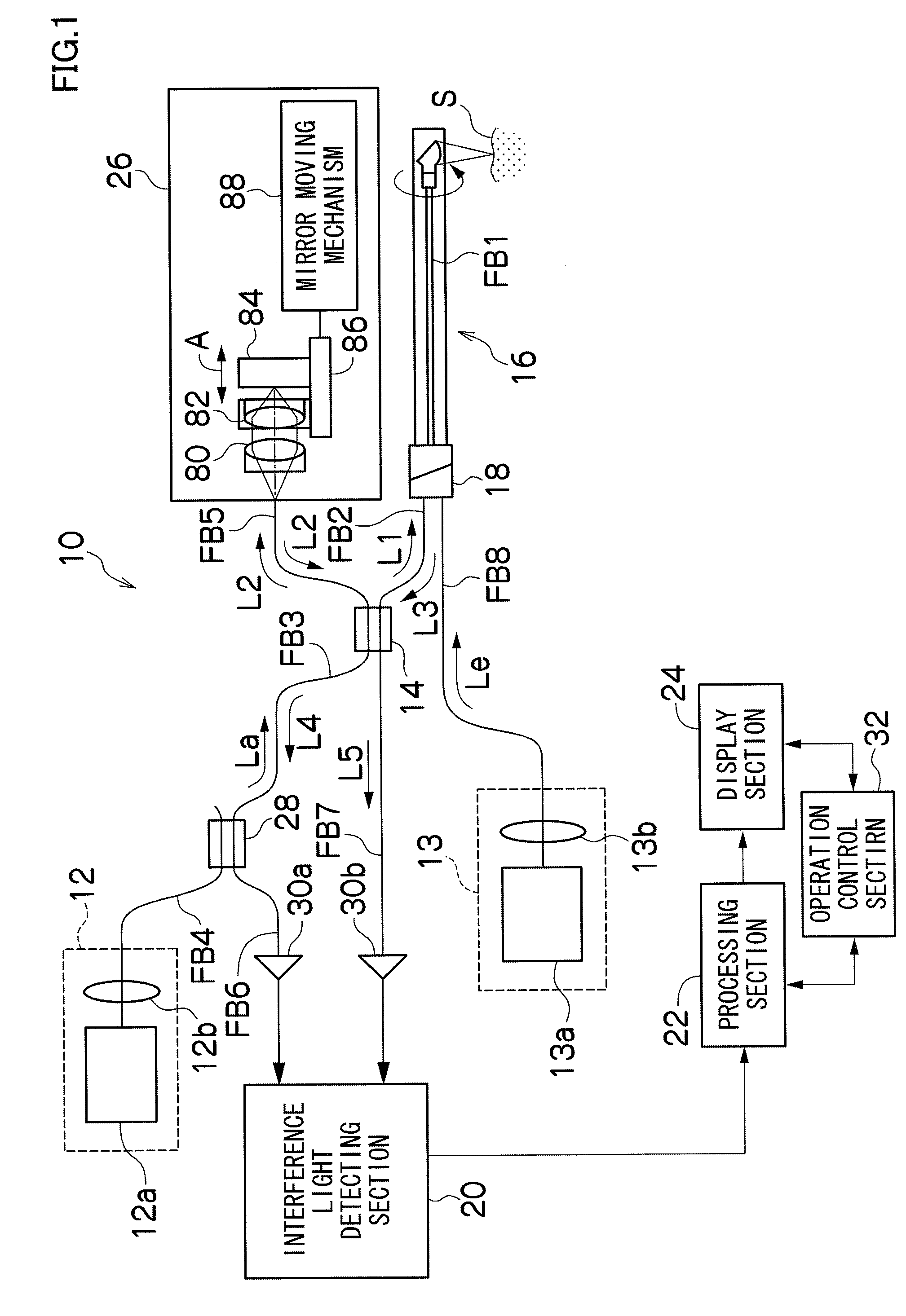Optical rotary adaptor and optical tomographic imaging apparatus using the same
- Summary
- Abstract
- Description
- Claims
- Application Information
AI Technical Summary
Benefits of technology
Problems solved by technology
Method used
Image
Examples
first embodiment
[0039]FIG. 1 is a block diagram showing a schematic configuration of an optical tomographic imaging apparatus using an optical rotary adapter according to the present invention.
[0040]An optical tomographic imaging apparatus 10 according to the present invention shown in FIG. 1, which is used to acquire an optical tomographic image of a measuring object by an optical coherence tomography (OCT) measuring method, includes: a first light source (first light source unit) 12 which emits a light beam for measurement La; an optical fiber coupler (branching / multiplexing section) 14 which branches the light beam La emitted from the first light source 12 into a measuring light beam (first luminous flux) L1 and a reference light beam L2, and which multiplexes the reference light beam L2 with a return light beam L3 from a measuring object S as a subject, to generate an interference light beam L4; an optical probe 16 including a rotation side optical fiber FB1 which guides the measuring light bea...
second embodiment
[0132]Next, there will be described an optical rotary adapter according to the present invention.
[0133]FIG. 4 is a schematic sectional view of an optical rotary adapter according to the second embodiment.
[0134]As shown in FIG. 4, an optical rotary adapter 218 according to the second embodiment is configured such that the positions of the dichroic mirror 101b and the optical-axis compensating plate 101a of the multiplexing device 110 in the optical rotary adapter 18 of the above described first embodiment are replaced in the light traveling direction and their arrangement is reversed.
[0135]That is, in a multiplexing device 210 arranged in the parallel light beam forming section in the fixed sleeve 38 of the present embodiment, the dichroic mirror 101b is arranged on the side nearer to the fixed side collimator lens 42, and the optical-axis compensating plate 101a is arranged on the side nearer to the rotation side collimator lens 50. Further, the dichroic mirror 101b and the optical-...
third embodiment
[0139]Next, there will be described a third embodiment according to the present invention.
[0140]FIG. 5 is a schematic sectional view showing an optical rotary adapter according to the third embodiment.
[0141]As shown in FIG. 5, in an optical rotary adapter 318 of the third embodiment, a multiplexing device 310 is configured by using a trapezoidal prism 201 having two surfaces which face each other and are inclined at respective angles having the same magnitude in the opposite directions, instead of the dichroic mirror 101b and the optical-axis compensating plate 101a of the multiplexing device 110 in the optical rotary adapter 18 according to the above described first embodiment.
[0142]The trapezoidal prism 201 is fixed in the fixed sleeve 38 by a prism holder 202 and a prism fixing ring 203. The two oppositely facing surfaces 201a and 201b positioned in the light traveling direction of the trapezoidal prism 201 are respectively formed at angles having the same magnitude in the opposi...
PUM
 Login to View More
Login to View More Abstract
Description
Claims
Application Information
 Login to View More
Login to View More - R&D
- Intellectual Property
- Life Sciences
- Materials
- Tech Scout
- Unparalleled Data Quality
- Higher Quality Content
- 60% Fewer Hallucinations
Browse by: Latest US Patents, China's latest patents, Technical Efficacy Thesaurus, Application Domain, Technology Topic, Popular Technical Reports.
© 2025 PatSnap. All rights reserved.Legal|Privacy policy|Modern Slavery Act Transparency Statement|Sitemap|About US| Contact US: help@patsnap.com



